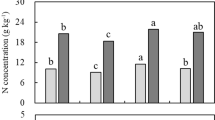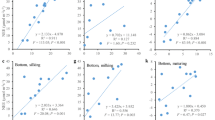Abstract
To analyze the daytime and phenological variations of canopy O3 and CO2 uptake of winter wheat, the canopy fluxes of wheat plants were measured using a chamber system with four different O3 levels (0, 40, 80, and 120 nmol mol−1) being applied. During the daytime (7:30–18:00 hours), canopy fluxes usually peaked around noon in early growing stages, while a generally decreasing trend from morning to afternoon was observed in the later stages. O3 and CO2 fluxes were positively and negatively correlated with O3 concentration, respectively. Significant differences were observed in O3 fluxes but CO2 fluxes among O3 treatments. Photosynthetically active radiation (PAR) and vapor pressure deficit (VPD) could affect canopy gas uptake in opposite ways. On the phenological timescale, both O3 and CO2 fluxes followed the variation of leaf area index (LAI) with the maximum occurring simultaneously at the booting stage. The daytime mean fluxes varied from −10.6 to −17.2 nmol m−2 s−1 for O3 and from −5.9 to −19.6 μmol m−2 s−1 for CO2. Quantitatively important O3 deposition (−3.1∼−11.6 nmol m−2 s−1) was also observed at night with the ratios being about 40∼70 % relative to the daytime O3 fluxes for most measuring days, which indicates a significant contribution from non-stomatal components to canopy O3 removal. This study confirms that environmental variables and plant phenology are important factors in regulating canopy O3 and CO2 uptake. O3 exposure (≤120 nmol mol−1) could not significantly affect the CO2 uptake of wheat canopy in a short time (ca. 10 min).







Similar content being viewed by others
References
Altimir, N., Vesala, T., Keronen, P., Kulmala, M., & Hari, P. (2002). Methodology for direct field measurements of ozone flux to foliage with shoot chambers. Atmospheric Environment, 36, 19–29.
Amiro, B. D., Gillespie, T. J., & Thurtell, G. W. (1984). Injury response of Phaseolus vulgaris to ozone flux density. Atmospheric Environment, 18, 1207–1215.
Buck, A. L. (1981). New equations for computing vapor pressure and enhancement factor. Journal of Applied Meteorology, 20, 1527–1532.
Castagna, A., Nali, C., Ciompi, S., Lorenzini, G., Soldatini, G. F., & Ranieri, A. (2001). Ozone exposure affects photosynthesis of pumpkin (Cucurbita pepo) plants. New Phytologist, 152, 223–229.
LRTAP Convention (2010). Mapping Manual 2004. Manual on methodologies and criteria for modeling and mapping critical loads & levels and air pollution effects, risk and trends. Chapter 3. Mapping critical levels for vegetation, 2010 revision. Available from: http://icpvegetation.ceh.ac.uk
Ennis, C. A., Lazrus, A. L., Kok, G. L., Zimmerman, P. R., & Monson, R. K. (1990). A branch chamber system and techniques for simultaneous pollutant exposure experiments and gaseous flux determinations. Tellus B, 42, 170–182.
Fares, S., McKay, M., Holzinger, R., & Goldstein, A. H. (2010). Ozone fluxes in a Pinus ponderosa ecosystem are dominated by non-stomatal processes: evidence from long-term continuous measurements. Agricultural and Forest Meteorology, 150, 420–431.
Feng, Z. W., Jin, M. H., Zhang, F. Z., & Huang, Y. Z. (2003). Effects of ground-level ozone (O-3) pollution on the yields of rice and winter wheat in the Yangtze River Delta. Journal of Environmental Sciences-China, 15, 360–362.
Feng, Z., Kobayashi, K., & Ainsworth, E. A. (2008). Impact of elevated ozone concentration on growth, physiology, and yield of wheat (Triticum aestivum L.): a meta-analysis. Global Change Biology, 14, 2696–2708.
Fowler, D., Flechard, C., Cape, J. N., Storeton-West, R. L., & Coyle, M. (2001). Measurements of ozone deposition to vegetation quantifying the flux, the stomatal and non-stomatal components. Water, Air, and Soil Pollution, 130, 63–74.
Fuentes, J. D., & Gillespie, T. J. (1992). A gas-exchange system to study the effects of leaf surface wetness on the deposition of ozone. Atmospheric Environment Part a-General Topics, 26, 1165–1173.
Garcia, R. L., Norman, J. M., & McDermitt, D. K. (1990). Measurements of canopy gas exchange using an open chamber system. Remote Sensing Reviews, 5, 141–162.
Gerosa, G., Cieslik, S., & Ballarin-Denti, A. (2003). Micrometeorological determination of time-integrated stomatal ozone fluxes over wheat: a case study in Northern Italy. Atmospheric Environment, 37, 777–788.
Grimm, A. G., & Fuhrer, J. (1992a). The response of spring wheat (Triticum aestivum L) to ozone at higher elevations. I. Measurement of ozone and carbon-dioxide fluxes in open-top field chambers. New Phytologist, 121, 201–210.
Grimm, A. G., & Fuhrer, J. (1992b). The response of spring wheat (Triticum aestivum L.) to ozone at higher elevations. III. Responses of leaf and canopy gas exchange, and chlorophyll fluorescence to ozone flux. New Phytologist, 122, 321–328.
Grulke, N. E., Paoletti, E., & Heath, R. L. (2007). Comparison of calculated and measured foliar O-3 flux in crop and forest species. Environmental Pollution, 146, 640–647.
Kanerva, T., Regina, K., Ramo, K., Ojanpera, K., & Manninen, S. (2007). Fluxes of N2O, CH4 and CO2 in a meadow ecosystem exposed to elevated ozone and carbon dioxide for three years. Environmental Pollution, 145, 818–828.
Kerstiens, G., Federholzner, R., & Lendzian, K. J. (1992). Dry deposition and cuticular uptake of pollutant gases. Agriculture, Ecosystems & Environment, 42, 239–253.
Kupisch, M., Stadler, A., Langensiepen, M., & Ewert, F. (2015). Analysis of spatio-temporal patterns of CO2 and H2O fluxes in relation to crop growth under field conditions. Field Crops Research, 176, 108–118.
Laisk, A., Kull, O., & Moldau, H. (1989). Ozone concentration in leaf intercellular air spaces is close to zero. Plant Physiology, 90, 1163–1167.
Meehl, G.A., Stocker, T.F., Collins, W.D., Friedlingstein, P., Gaye, A.T., Gregory, J.M., et al. (2007). Global Climate Projections. In: Climate Change 2007: The Physical Science Basis. Contribution of Working Group I to the Fourth Assessment Report of the Intergovernmental Panel on Climate Change [Solomon, S., Qin, D., Manning, M., Chen, Z., Marquis, M., Averyt, K.B., Tignor, M., Miller, H.L. (Eds.)]. Cambridge University Press, Cambridge, United Kingdom and New York, NY, USA. pp. 747–845
Mishra, A. K., Rai, R., & Agrawal, S. B. (2013). Individual and interactive effects of elevated carbon dioxide and ozone on tropical wheat (Triticum aestivum L.) cultivars with special emphasis on ROS generation and activation of antioxidant defence system. Indian Journal of Biochemistry & Biophysics, 50, 139–149.
Ohkubo, S., Nagata, O., & Hirota, T. (2015). Estimating nee in a wheat-planted plot with an automatically controlled chamber. Soil Science & Plant Nutrition, 61(1), 76–87.
Palaniswamy, K., & Gomez, K. (1974). Length-width method for estimating leaf area of rice. Agronomy Journal, 66(3), 430–433.
Pleijel, H., Danielsson, H., Karlsson, G. P., Gelang, J., Karlsson, P. E., & Sellden, G. (2000). An ozone flux-response relationship for wheat. Environmental Pollution, 109, 453–462.
Pleijel, H., Danielsson, H., Emberson, L., Ashmore, M. R., & Mills, G. (2007). Ozone risk assessment for agricultural crops in Europe: further development of stomatal flux and flux-response relationships for European wheat and potato. Atmospheric Environment, 41, 3022–3040.
Potier, E., Ogée, J., Jouanguy, J., Lamaud, E., Stella, P., Personne, E., Durand, B., Mascher, N., & Loubet, B. (2015). Multilayer modelling of ozone fluxes on winter wheat reveals large deposition on wet senescing leaves. Agricultural and Forest Meteorology, 211, 58–71.
Rai, R., Agrawal, M., & Agrawal, S. B. (2011). Effects of ambient O-3 on wheat during reproductive development: gas exchange, photosynthetic pigments, chlorophyll fluorescence, and carbohydrates. Photosynthetica, 49, 285–294.
Roshchina, V. V., & Roshchina, V. D. (2003). Ozone and plant cell (pp. 31–34). Dordrecht, Netherlands: Kluwer Academic Publishers.
Shi, L., Hu, Y. G., & Liu, X. P. (2011). Comparative studies on photosynthetic and fluorescence characteristics of different winter wheat varieties (lines). Acta Agriculturae Boreali-Occidentalis Sinica, 20(2), 48–55.
Sild, E., Pleijel, H., & Selldén, G. (2002). Elevated ozone (O3) alters carbohydrate metabolism during grain filling in wheat (Triticum aestivum L.). Agriculture, Ecosystems & Environment, 92(1), 71–81.
Stella, P., Personne, E., Lamaud, E., Loubet, B., Trebs, I., & Cellier, P. (2013). Assessment of the total, stomatal, cuticular, and soil 2 year ozone budgets of an agricultural field with winter wheat and maize crops. Journal of Geophysical Research-Biogeosciences, 118, 1120–1132.
Tang, H., Takigawa, M., Liu, G., Zhu, J., & Kobayashi, K. (2013). A projection of ozone-induced wheat production loss in China and India for the years 2000 and 2020 with exposure-based and flux-based approaches. Global Change Biology, 19, 2739–2752.
Tong, L., Wang, X., Geng, C., Wang, W., Lu, F., Song, W., et al. (2011). Diurnal and phenological variations of O-3 and CO2 fluxes of rice canopy exposed to different O-3 concentrations. Atmospheric Environment, 45, 5621–5631.
Vingarzan, R. (2004). A review of surface ozone background levels and trends. Atmospheric Environment, 38, 3431–3442.
Wang, X. P., & Mauzerall, D. L. (2004). Characterizing distributions of surface ozone and its impact on grain production in China, Japan and South Korea: 1990 and 2020. Atmospheric Environment, 38, 4383–4402.
Wang, X., Manning, W., Feng, Z., & Zhu, Y. (2007). Ground-level ozone in China: distribution and effects on crop yields. Environmental Pollution, 147, 394–400.
Wang, W., Liao, Y., Wen, X., & Guo, Q. (2013). Dynamics of CO2 fluxes and environmental responses in the rain-fed winter wheat ecosystem of the Loess Plateau, China. Science of the Total Environment, 461, 10–18.
Xu, W. Z., Deng, X. P., & Xu, B. C. (2013). Effects of water stress and fertilization on leaf gas exchange and photosynthetic light-response curves of Bothriochloa ischaemum L. Photosynthetica, 51, 603–612.
Zhang, X., Fan, C., Ma, Y., Liu, Y., Li, L., Zhou, Q., et al. (2014). Two approaches for net ecosystem carbon budgets and soil carbon sequestration in a rice–wheat rotation system in China. Nutrient Cycling in Agroecosystems, 100(3), 301–313.
Zheng, Y., Mai, B., Wu, R., Feng, Y., Sofo, A., Ni, Y., et al. (2011). Acclimation of winter wheat (Triticum aestivum, cv. Yangmai 13) to low levels of solar irradiance. Photosynthetica, 49, 426–434.
Zhu, Z.-L., Sun, X.-M., Zhao, F.-H., Wen, X.-F., Tang, X.-Z., & Yuan, G.-F. (2012). Variation of ozone concentration of winter wheat field and mechanistic analysis of its possible effect on wheat yield in Northwest-Shandong Plain of China. Chinese Journal of Plant Ecology, 36, 313–323.
Zhu, Z., Sun, X., Zhao, F., & Meixner, F. X. (2015). Ozone concentrations, flux and potential effect on yield during wheat growth in the Northwest-Shandong plain of china. Journal of Environmental Sciences, 8, 1–9.
Acknowledgments
The research was supported by the Ministry of Environmental Protection (No. 200809152).
Author information
Authors and Affiliations
Corresponding author
Rights and permissions
About this article
Cite this article
Tong, L., Xiao, H., Qian, F. et al. Daytime and Phenological Characteristics of O3 and CO2 Fluxes of Winter Wheat Canopy Under Short-Term O3 Exposure. Water Air Soil Pollut 227, 4 (2016). https://doi.org/10.1007/s11270-015-2698-6
Received:
Accepted:
Published:
DOI: https://doi.org/10.1007/s11270-015-2698-6




